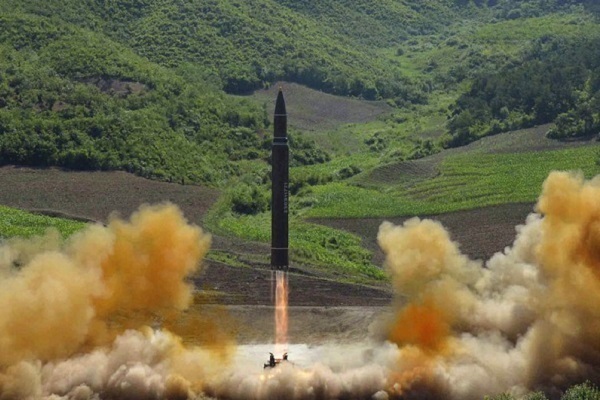N. Korea unlikely to field solid-fuel ICBM within decade
By YonhapPublished : Aug. 27, 2017 - 20:46
North Korea is unlikely to field a solid-fuel intercontinental ballistic missile (ICBM) within a decade given its relative inexperience, an expert has said amid growing concerns over Pyongyang's fast-paced weapons development.
In his article posted Friday on 38 North, the US-based North Korea monitoring website, Michael Elleman, senior fellow for missile defense at the International Institute for Strategic Studies, made the remarks, while analyzing several photos of North Korean leader Kim Jong-un's recent visit to the Chemical Material Institute of the Academy of Defense Sciences.

Elleman noted the North's largest tested solid motor is the Pukguksong missile's first stage, which weighs about 6 to 7 tons, while an ICBM first-stage motor will weigh around 20 tons. The step from producing 6-ton motors to 20-ton motors requires seven to 10 years, he said.
"North Korea might be able to shorten the timeframe by a few years by taking shortcuts and accepting reductions in performance and reliability," he wrote in the article. "But given the country's relative inexperience with solid-propellant production, an ICBM founded on solid-fuels is unlikely to be fielded within a decade."
The reclusive state has continued to aggravate security concerns in Seoul and Washington with its evolving nuclear and missile programs. Its two ICBM tests last month reaffirmed it is on course in the development of a nuclear-tipped ICBM, which Seoul views as a "red line."
In his article, Elleman analyzed a large filament-wound composite vessel shown in the North Korean leader's inspection photo.
The expert explained that the large bronze-colored vessel -- whose size is roughly 1.4-1.5 meters in diameter -- is an advanced, light-weight casing designed to house solid propellant.
He also pointed to a filament-winding machine in the photo, which is presumably used to manufacture the composite-motor casing.
Solid-fueled rocket motors consist of a casing, solid propellant, ignitor and other components, he said.
"It is unclear if the machine can produce motor casings larger than a 1.5 meter diameter. If not, North Korea will need to acquire a larger winding machine to produce motor casings large enough to power intercontinental ballistic missiles," he said.
The expert also explained the conceptual illustrations of the two missiles shown in the photo -- the Pukguksong-3 and Hwasong-13.
The Puguksong-3 missile seems to be an advanced version of the solid-fuel Pukguksong-1 and 2, he said.
"If North Korea masters the production processes, maintains a reliable supply chain for the filaments and resins needed to create the cases, and adheres to strict quality control procedures, the Pukguksong-3 might be capable of reaching targets 2,000 kilometers away," he said, noting the present reach of the Pukguksong-1 and 2 stands at around 1,200 km. (Yonhap)


![[Exclusive] Korean military set to ban iPhones over 'security' concerns](http://res.heraldm.com/phpwas/restmb_idxmake.php?idx=644&simg=/content/image/2024/04/23/20240423050599_0.jpg&u=20240423183955)

![[Graphic News] 77% of young Koreans still financially dependent](http://res.heraldm.com/phpwas/restmb_idxmake.php?idx=644&simg=/content/image/2024/04/22/20240422050762_0.gif&u=)



![[Pressure points] Leggings in public: Fashion statement or social faux pas?](http://res.heraldm.com/phpwas/restmb_idxmake.php?idx=644&simg=/content/image/2024/04/23/20240423050669_0.jpg&u=)










